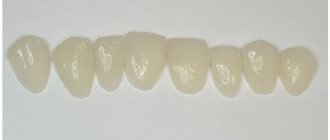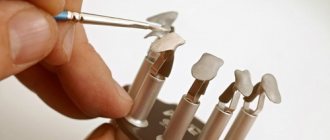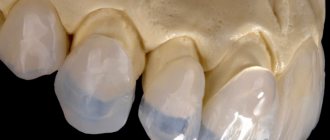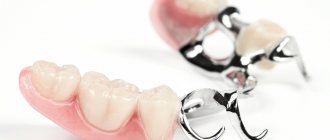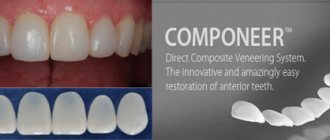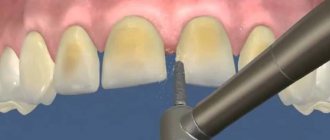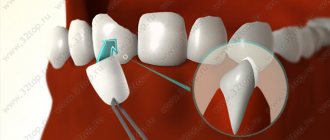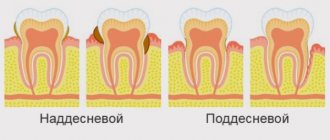Purpose of veneers
Veneers are thin overlays on teeth, their thickness does not exceed 0.5 mm. They are made from a special material - composite or medical porcelain. The material does not disturb the natural acid-base balance in the oral cavity and is biologically compatible with the mucous membrane.
Removable veneers solve many problems with smile aesthetics:
- create the impression of an even row of teeth;
- give the impression of snow-white enamel.
Even if you have money, it is not always possible to achieve snow-white enamel. A person with a yellowish natural bone color will never have a snow-white smile, even modern whitening products will not help. The structural features of the enamel (too thin layer) are also an obstacle to mechanical teeth whitening. Therefore, removable veneers are a solution to the problem of smile aesthetics without complex dental procedures.
Installation recommendations:
- congenital yellowness of enamel;
- cosmetic defects of the dentition;
- yellowness of the enamel due to consumption of coffee, tea, cigarettes;
- enamel fluorosis (white or dark spots);
- pathology of the enamel coating due to frequent bleaching;
- slight curvature of teeth that cannot be corrected;
- large gaps between teeth;
- discoloration of fillings on the front teeth;
- exposure of roots.
Installation ban:
- bruxism;
- malocclusion;
- presence of bad habits (smoking);
- the habit of putting objects into the mouth (pens, pencils, fingers);
- multiple fillings on the front teeth;
- gum problems.
Bruxism is not a categorical prohibition on installing veneers. Grinding can be eliminated with the help of special mouth guards that are worn before bed.
Why is malocclusion an obstacle to installing veneers? Because the material will quickly fail and wear off. With an incorrect bite, the chewing load is distributed unevenly, which negatively affects the condition of the teeth and premature wear of the enamel.
Flaws
- They require careful treatment and careful care;
- some types require preliminary grinding of the enamel;
- are much more expensive than regular crowns;
- do not eliminate malocclusion;
- do not strengthen teeth.
When installing veneers, you should forget about seeds and other solid foods, as they can damage them.
Grinding of the enamel layer is the biggest disadvantage of overlay veneers. If the pain threshold is exceeded, the patient may experience constant discomfort even after the plates are installed. The enamel layer is not renewed, so after removing the onlays it is necessary to carry out restoration.
Indications
Microprosthetics in some cases is the best solution to the problem.
Dentists recommend installing veneers in the following cases:
- For chips, cracks and uneven enamel.
- Change in color that cannot be bleached.
- Uneven row.
- For crooked or underdeveloped teeth.
- Pathological abrasion of enamel.
Russian technologies for manufacturing composites differ from Western ones. In European dental clinics, onlays are made in a special dental laboratory, and impressions are used after grinding and preparation. In Russia, dental plates are more like ordinary fillings. They are installed directly into the patient's mouth.
Varieties
Onlays can be made of composite material or medical porcelain and zirconium. Porcelain products are more durable, but more expensive. Composite structures will last from three to five years, then they should be replaced with new ones. The advantages of composite veneers include price and ease of removal/installation. Componeers (composite plates) require more careful care and regular visits to the dentist to coat the surface with a special varnish.
The most reliable are zirconium linings; they can last more than twenty years. However, they do not look natural; this is noticeable to the naked eye. The artificiality of zirconium overlays is explained by the lack of light conductivity. Another disadvantage is the need for strong grinding of the enamel before installing them.
However, the biggest disadvantage of installing overlays made of any material is the loss of part of the enamel layer.
Lumineers
These overlays are called Hollywood and differ from ordinary veneers in their thinness. They are made from transparent porcelain and attached using a special adhesive.
Lumineers are highly durable and can last up to twenty years with proper care. Do not stain when eaten. However, Lumineers are not suitable for everyone. Lumineers are so transparent that they cannot mask stains or yellowness of the enamel layer.
There is another significant drawback of lumineers - when removing the plates, the enamel coating is inevitably destroyed. This is due to the peculiarity of the cementing composition on which the linings are attached: it is too strong.
Removable veneers perfect smile
This prosthesis imitates the gums and upper teeth. Used in emergency cases when a beautiful smile is needed. This is an invention of American orthodontists. The prosthesis provides a snow-white smile without preliminary grinding of the enamel and a visit to the dentist’s office.
How to use removable perfect smile veneers? It's very easy to do. Before the first fitting, the prosthesis should be placed in a glass of boiling water for several minutes so that the material becomes pliable. Then the denture is removed and applied to the upper teeth, holding it with your hand for 1-2 minutes. During this time, the material of the product will take its shape and remember its location. For subsequent uses, do not place the prosthesis in boiling water.
How often can you wear a perfect smile? The prosthesis is worn any time a charming smile is needed. How long can I wear a prosthesis? You can wear your perfect smile all day long, but before going to bed you need to remove it and wash it. Wash the denture with plain water and periodically clean it with mouthwash.
Ultraneers
Ultraneers are made from pressed ceramic chips. The advantages of onlays include quick adaptation, since the patient practically does not feel the foreign body in the mouth. The products look natural and are indistinguishable from real teeth. Lumineers are manufactured in the USA, so the cost of installation is always very high. Ultraneers are three times cheaper, since they are produced in Russia.
However, installation of ultraneers sometimes requires grinding of the enamel. The quality of ultraneers is inferior to lumineers in many respects, but they are cheaper. Ultraneers are also an alternative to aggressive whitening, as they protect the enamel from thinning.
Ultraneers are installed in two visits to the orthodontist’s office: during the first visit, an impression of the jaw is made, and on the second, onlays are installed. Ultraneers are easily removable and can be replaced with ceramic or zirconium veneers.
Which material to choose
Which overlays are preferable and what to choose to improve the aesthetics of your smile? When choosing a material, you should consider some factors:
- naturalness when smiling;
- for minor cosmetic imperfections, you can safely choose lumineers;
- For the correction of two or three teeth, overlay plates made of composite materials are quite suitable.
The most expensive ones are zirconium plates and lumineers. Zirconium veneers are the leaders in terms of reliability and strength, while lumineers are the leaders in terms of aesthetics and beauty. The most short-lived ones are composite linings (sometimes they lose their properties after 3 years).
Front Row Correction
The aesthetics of a smile is the main requirement for overlay plates. For large enamel defects or chips, the best solution to camouflage the front teeth is ceramics (porcelain). Ceramic overlays look as natural as possible, they are translucent and perfectly transmit light rays. With the help of ceramic overlays you can correct such significant defects as:
- large gaps;
- missing half of a tooth after injury;
- strong yellowness of the enamel;
- stains on enamel from cigarettes, strong tea/coffee;
- slight curvature of the dentition.
Ceramic veneers are expensive, but with good care they last a long time. If you don’t bite seeds or open beer caps on a bottle with your teeth, ceramic linings will last for more than ten years.
You can also restore your front teeth using composite onlays, but they will only last 4-5 years. They are several times cheaper than ceramic ones. Also, the composite begins to change its shade over time due to food.
Correction of chewing teeth
What onlays should be chosen to cover the chewing molars? Ceramic and composite veneers are the least suitable for these purposes. Zirconium ones are more reliable and durable; they will withstand any chewing loads. Zirconium plates are expensive, but justify the cost with a long service life.
Method of attaching veneers
There are two methods of installing veneers in orthodontics:
- straight;
- indirect.
The indirect method involves creating onlays based on a cast of the jaw. However, this technique is applied only to products made of ceramics and zirconium; no processing is required for composite materials. Before installation, the inner surface of the overlay plate is treated with a special adhesive. Next, the surface of the tooth is degreased. After this, the lubricant is washed off and the surface is dried. Next, the enamel is lubricated with an adhesive mass, and a plate is installed on the tooth. For more reliable fixation, the installed plate is treated with a light lamp.
While ceramic and zirconium veneers are made by a dental technician in a laboratory based on an impression of the jaw, composite veneers are formed directly on the patient’s tooth. To do this, the dentist first carries out an antiseptic treatment. Then the composite material is applied to the tooth in layers and dried with an LED lamp. The procedure takes a sufficient amount of time, but the patient immediately leaves the doctor’s office with a beautiful smile.
The direct method of installing veneers is optimal in the presence of large chips and cracks on the surface of the molars. It restores the tooth and restores its original shape. Even if more than half of a molar is missing, the direct method of installing veneers will help restore what was lost using composite material. The method is reminiscent of placing a light filling, which is also made of a composite material and dried with a lamp.
Is the composition used to attach veneers harmful to dental health? The composition of the adhesive composition includes fluorine and other microelements useful for enamel, so dental glue is completely safe.
Do your teeth hurt after grinding? Some patients are very sensitive to the removal of the enamel coating and may feel pain for several days in a row after turning. If the pain becomes unbearable, you should take a pain reliever. After a few days, the pain will go away. If the pain does not go away for a long time, you need to notify your dentist.
Intraoral scanner ensures optical accuracy of aligners
To make the aligners, we used an intraoral scanner, which was used to take optical impressions. That is, the camera takes many pictures, which are stitched into a 3D image in a special program. And this 3D image is sent to the laboratory, bypassing transport and time losses, bypassing shrinkage and all kinds of force majeure circumstances - hypothermia of the impression masses. Accordingly, we get a more accurate, more predictable result.
Anna
: The teeth scanning took place there for 15 minutes. And a week later, at a follow-up appointment, I was able to immediately see how my teeth would move.
Doctor Arkashov
: That is, by the time we received the result from the laboratory with the final treatment plan, we had not yet done anything to our patient. The result that we get after aligners will be appreciated by the patient. And we, as a rule, allow you to look at the result of orthodontic treatment. And many patients are satisfied with it.
Installation steps
Ceramic and zirconium overlays are installed within 10-14 days. This involves making veneers from an impression by a dental technician. While the ceramic products are being prepared, temporary plastic onlays are installed on the patient. This is necessary to protect the ground teeth from thermal influences when eating and the psychological comfort of the patient.
First, the dentist examines the oral cavity and determines the presence of teeth damaged by caries. Only after this the doctor begins work on installing veneers.
The surface layer of enamel is ground under local anesthesia. This is necessary so that the onlay fits perfectly on the tooth and looks natural. If the enamel is not sharpened, the plates will look very large and unnatural.
After grinding, an impression is made of the molars that require correction. The impression is transferred to the dental technician, who forms onlays for each molar separately.
The doctor then places temporary plastic onlays on the ground teeth in anticipation of permanent veneers.
After a couple of weeks, the patient is fitted with ceramic/zirconium veneers or lumineers.
Veneer care
Oral care remains the same - twice a day. However, the paste should not contain abrasive substances, and the brush should not be hard. If it is not possible to properly clean teeth in hard-to-reach places, it is necessary to regularly visit the dental office for professional cleaning.
Veneers are made of fragile materials (except zirconium), so they should be taken care of. You should not crack seeds, chew nuts, indulge in candy, or eat solid foods (raw carrots, apples). Ceramic can crack easily and can be expensive to replace. Therefore, after installing the pads, your diet should be reconsidered.
Nicotine is well absorbed into any surface, so smoking after installation of veneers is not recommended.
Gum disease can ruin all your efforts to achieve a beautiful smile. If your gums start to bleed, visit your dentist immediately. Bleeding, loose gums will not be able to hold teeth in their sockets and will cause unsteadiness and even loss. Therefore, paying attention to your gums is the key to health and a beautiful smile.
What are temporary veneers, why get them and how long will you have to wear them?
Today, installing veneers that make a smile attractive is a procedure that is available to everyone. And almost a century ago, only Hollywood actors could afford them, and even then not for long - only for the period of time while filming took place. Celebrity stylists put thin plates on the teeth as a kind of make-up or disguise defects, and glued them with a temporary composition. After 1-2 days, such overlays were removed. Today, high-quality veneers that are installed in dental offices are permanent structures that serve their owners for 5-7 or more years (depending on the properties of the selected material). However, on the Internet you can find information about removable veneers. What are these structures? Find out more in our article today!
Bottom line
Perfect smile veneers are an imitation of the upper row of teeth along with the gums, thanks to which you can not be afraid to smile openly and joke. The perfect smile removable denture does not require a visit to the orthodontist or preliminary teeth grinding. To get a snow-white smile, you just need to put the denture on the upper jaw and hold it lightly until it takes the anatomical shape of your teeth. However, the perfect smile has a drawback: the lack of imitation of the lower jaw.
To correct small defects in the dentition, you can purchase lumineers: their installation does not require grinding of the enamel. If there are significant defects in the dentition, lumineers will not help, as they are made of completely transparent material. To correct large defects, ceramic onlays or plates made of composite material are required.
Sources used:
- The National Center for Biotechnology Information (USA)
- Proffitt U.R., Modern orthodontics (3rd edition), MEDpress-inform, 2015, 560 p.
- “Orthopedic treatment with fixed prostheses” (Rozenstiel S.F.)
Perfect Smile Veneers instructions in Russian
The product was originally produced and distributed on the American market, so translated instructions appeared later.
The standard package includes a removable plate. Place Perfect Smile Veneers in hot water for two minutes. Polypropylene will become softer and acquire a consistency similar to plasticine. You need to keep the plate in boiling water until the white stripe on the back side becomes transparent.
Then you need to get the veneers. This can be done using a spoon.
Now you need to create a cast. The plate must be pressed firmly against the front surface of the teeth for a minute so that the material takes the shape of the jaw.
Removable teeth must completely harden outside the oral cavity. To achieve maximum effect, it is recommended to hold the product under cold water for several seconds.
If the first time it was not possible to create an ideal and convenient shape, you should immerse the polypropylene in boiling water again. After several procedures, an individual method of putting on the overlay is formed.
Universal videos about the product contain complete information about how veneers are used in real life. You can also read numerous reviews or add your own.
Veneers do not require the application of additional adhesive agents such as gel or cream. They are easily attached to dental surfaces.
In order to remove the structure, no additional effort is required.

